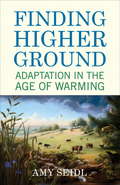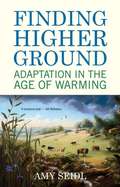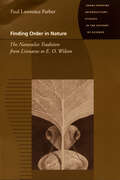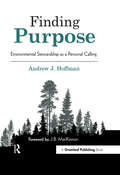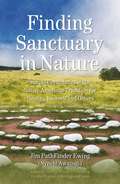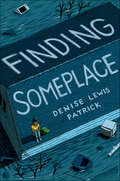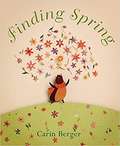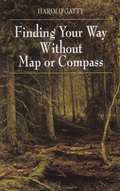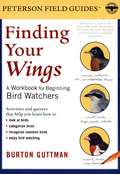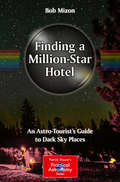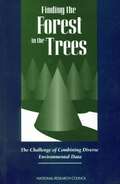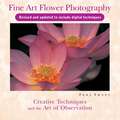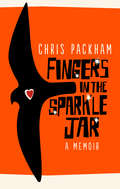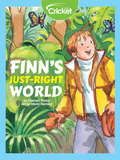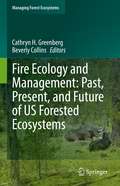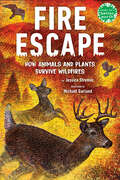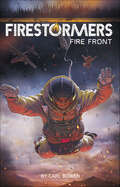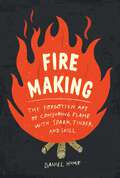- Table View
- List View
Finding Higher Ground
by Amy SeidlWhile much of the global warming conversation rightly focuses on reducing our carbon footprint, the reality is that even if we were to immediately cease emissions, we would still face climate change into the next millennium. In Finding Higher Ground, Amy Seidl takes the uniquely positive--yet realistic--position that humans and animals can adapt and persist despite these changes. Drawing on an emerging body of scientific research, Seidl brings us stories of adaptation from the natural world and from human communities. She offers examples of how plants, insects, birds, and mammals are already adapting both behaviorally and genetically. While some species will be unable to adapt to new conditions quickly enough to survive, Seidl argues that those that do can show us how to increase our own capacity for resilience if we work to change our collective behavior. In looking at climate change as an opportunity to establish new cultural norms, Seidl inspires readers to move beyond loss and offers a refreshing call to evolve.From the Hardcover edition.
Finding Higher Ground: Adaptation in the Age of Warming
by Amy SeidlAn ecologist takes the uniquely positive--yet realistic--position that we can adapt and persist despite the inevitable effects of climate change. While much of the global warming conversation rightly focuses on reducing our carbon footprint, the reality is that even if we were to immediately cease emissions, we would still face climate change into the next millennium. In Finding Higher Ground, Amy Seidl takes the uniquely positive--yet realistic--position that humans and animals can adapt and persist despite these changes. Drawing on an emerging body of scientific research, Seidl brings us stories of adaptation from the natural world and from human communities. She offers examples of how plants, insects, birds, and mammals are already adapting both behaviorally and genetically. Within ten years, one plant species in a drought-stricken area has evolved to fit its life cycle into the shorter growing season. Red squirrels are breeding earlier to take advantage of the food supplied by an earlier spring. And some birds are migrating shorter distances, or not at all, as their northern habitats become milder. While some species will be unable to adapt to new conditions quickly enough to survive, Seidl argues that those that do can show us how to increase our own capacity for resilience. She tells of a young farmer experimenting with adaptive strategies for local crops, architects using biomimicry to design buildings that actually contribute to their surrounding ecosystems, and the establishment of decentralized and renewable energy banks. While Seidl admits that these efforts alone won't change the world, she hopes that taken together they can form the basis for a new, revolutionary set of ideas to live by, much like the efforts that brought about abolition, women's suffrage, and the eight-hour workday. In looking at climate change as an opportunity to establish new cultural norms, Seidl's perspective inspires readers to move beyond loss and offers a refreshing call to evolve.
Finding Home: Shelter Dogs & Their Stories
by Traer ScottHeart-touching photographs and rescue stories: &“Do yourself a favor. Read Finding Home, then go out and adopt a shelter dog.&” —Chicago Tribune Bold, retiring, serious, sparkling, or quirky—the dogs in Traer Scott&’s remarkable photographs regard us with humor, dignity, and an abundance of feeling. Scott began photographing these dogs in 2005 as a volunteer at animal shelters. Following the runaway success of her first book, Shelter Dogs, she now introduces a new collection of canine subjects, each with indomitable character and spirit: Morrissey, a pit bull, who suffered from anxiety-related behaviors brought on by shelter life until adopted by a family with four children Chloe, a young chocolate Lab mix, surrendered to a shelter by a family with allergies Gabriel and Cody, retired racing greyhounds Bingley, a dog who lost his hearing during a drug bust but was brought home by a loving family that has risen to the challenge of living with a deaf dog Through text and photos, we become better acquainted with the personalities and life stories of selected dogs and watch as they experience the sometimes rocky and always emotional transition to new homes. The portraits in Finding Home form an eloquent plea for more of the urgently needed adoptive families, as well as a tribute to dogs everywhere.
Finding Meaning in Wine: A US Blend (Routledge Food Studies)
by Michael SinowitzThis book examines controversies in American wine culture and how those controversies intersect with and illuminate current academic and cultural debates about the environment and about interpretation. With a specific focus on the United States of America, the methods that we use to discuss literature and other art are applied to wine-making and wine culture. The book explores the debates about how to evaluate wine and the problems inherent in numerical scoring as well as evaluative tasting notes, whether winemakers can be artists, the discourse in wine culture involving natural wine and biodynamic farming, as well as how people judge what makes a wine great. These interpretative commitments illuminate an underlying metaphysics and allegiance to a culture of reason or feeling. The discussions engage with a broad range of writers and thinkers, such as Roland Barthes, Susan Sontag, Louis Menand, Michael Pollan, Greg Garrard, John Guillory, Amitov Ghosh, Pierre Bourdieu, and Barbara Herrnstein-Smith. The book draws upon not only a number of texts produced by wine critics, wine writers, literary critics and theorists but also extensive interviews with wine writers and multiple California winemakers. These interviews contribute to a unique reflection on wine and meaning. This book will be of great interest to readers looking to learn more about wine from cultural, literary, and philosophical perspectives.
Finding Nevada Wild: The Terrain, Culture, and People of the Most Mysterious State in the West
by Sydney MartinezWhen many people think of Nevada, they think of Las Vegas, Area 51, and an unending, empty desert—but there&’s a lot more to the Great Basin State than that. Author and dedicated Nevada aficionado Sydney Martinez has devoted many years to exploring the ultra-rural wonders of Nevada, and in Finding Nevada Wild, she helps fellow adventurers get to know an often-misunderstood state. Written from the perspective of someone who has researched, visited, and experienced many of Nevada&’s most defining places, Finding Nevada Wild features chapters devoted to various interests and activities. Vivid photography accompanies personal stories and practical guidance to show why Nevada should be at the top of everyone&’s must-experience list.Key Features• Sections focusing on Nevada ghost towns and mining camps, darkness and quietness, camping, hot springs, great drives, rural bars, trails and streams, geology, and the people of Nevada • A personally curated list of the must-see places in ultra-rural Nevada that most people won&’t ever know • Historical and first-person experiential insights into Nevada&’s vast Indigenous, Basque, and Buckaroo legacies • Practical tips for navigating throughout some of the Lower 48&’s most isolated placesOffering a combination of content and design that is as equally at home on a coffee table as it is serving as a guidebook for unforgettable adventures in Nevada's ultra-rurals, Finding Nevada Wild helps readers to discover the true essence of the Silver State.
Finding Order In Nature: The Naturalist Tradition from Linnaeus to E. O. Wilson (Johns Hopkins Introductory Studies in th)
by Paul Lawrence Farber“Engaging . . . a concise work that gives the general reader a solid understanding . . . an excellent introduction to the history of natural history.” —Library JournalSince emerging as a discipline in the middle of the eighteenth century, natural history has been at the heart of the life sciences. It gave rise to the major organizing theory of life—evolution—and continues to be a vital science with impressive practical value. Central to advanced work in ecology, agriculture, medicine, and environmental science, natural history also attracts enormous popular interest.In Finding Order in Nature Paul Farber traces the development of the naturalist tradition since the Enlightenment and considers its relationship to other research areas in the life sciences. Written for the general reader and student alike, the volume explores the adventures of early naturalists, the ideas that lay behind classification systems, the development of museums and zoos, and the range of motives that led collectors to collect. Farber also explores the importance of sociocultural contexts, institutional settings, and government funding in the story of this durable discipline.“The history of natural history can rarely have been as succinctly told as in Paul Lawrence Farber’s 129-page Finding Order in Nature. From the intellectual revolutions of Linnaeus and Darwin through the Victorian obsessions with classifying and collecting, to the conservationists led by E. O. Wilson, it is an odyssey beautifully told.” —New Scientist“Farber does an impressive job of demonstrating how practitioners like Linnaeus, Buffon, Saint-Hilaire and Cuvier advanced the field and set the stage for the development of science as we know it today.” —Publishers Weekly
Finding Purpose: Environmental Stewardship as a Personal Calling
by Andrew J. HoffmanBoth thoughtful and thought-provoking, Finding Purpose aims to challenge our understanding of how humanity interacts with planet Earth, and our role within this. This book is an invitation: would you like to participate in one of the most important projects of imagination, perhaps the greatest ever, in human history? Distilling and refining over 20 pieces from a lifetime of work in academia and trade, across speeches, blogs, editorials and essays, Hoffman invites us to look beyond material growth and explore the role of the individual and business in discovering a wider purpose to bring about a balanced and sustainable society. The reader is encouraged to consider humanity’s relationship with the environment through different lenses: business, academia, faith-based and cultural. By bringing them together, Hoffman encourages us to understand our relationship with the planet in a far more holistic sense. Drawing on ideas from philosophy, literature, natural sciences and politics, Hoffman ensures that the ideas he explores are wholly accessible and applicable. Fully substantiated through various research and examples, the issues described are consistently made relevant to the reader.Finding Purpose is the perfect book for anyone – from student to CEO – thinking about their place in the world, and how making changes in our own lives and societies can impact on the world around us.
Finding Sanctuary in Nature
by Jim Pathfinder EwingThese spiritual lessons are based on Native American shamanism but fit a wide range of interests from yoga and alternative medicine to Bible study and nature hiking. Hands-on exercises, step-by-step instructions for ceremonies, and sketches by the author's wife explain how to clear spaces of unwanted energy, create simple ceremonies, connect with spirit guides and angels, and interpret symbols. An extended discussion tells how to make a medicine wheel that resembles a labyrinth and use it as an engine for distance healing. Additional ceremonies for daily living, healing the earth, and soul retrieval are also described, and the spiritual quest itself is shown to follow the process of choosing a sacred place in nature, finding a sacred place within oneself, and connecting to the inner and outer worlds. Readers are encouraged to keep a notebook about their spiritual growth and refer to the key words and suggestions for internet research that are included.
Finding Someplace
by Denise Lewis PatrickReesie Boone just knows that thirteen is going to be her best year yet-this will be the year she makes her very first fashion design on her Ma Maw's sewing machine. She'll skip down the streets of New Orleans with her best friends, Ayanna and Orlando, and everyone will look at her in admiration.But on Reesie's birthday, everything changes. Hurricane Katrina hits her city. Stranded at home alone, Reesie takes refuge with her elderly neighbor, Miss Martine. The waters rise. They escape in a boat. And soon Reesie is reunited with her family. But her journey back home has only begun.This is a story of a family putting itself back together, and a young girl learning to find herself.A Christy Ottaviano Book
Finding Spring
by Carin BergerInstead of hibernating as he should, a little bear cub goes out in search of spring—and he thinks he's found it! Gloriously illustrated with dioramas and cut-paper collages by the award-winning designer and illustrator Carin Berger, this stunning picture book celebrates the changing of the seasons.
Finding Wild
by Megan Wagner LloydA lovely, lyrical picture book with gorgeous illustrations that explores the ways the wild makes itself known to us and how much closer it is than we think. There are so many places that wild can exist, if only you know where to look! Can you find it? Two kids set off on an adventure away from their urban home and discover all the beauty of the natural world. From the bark on the trees to the sudden storm that moves across the sky to fire and flowers, and snowflakes and fresh fruit. As the children make their way through the woods and back to the paved and noisy streets, they discover that wild exists not just off in some distant place, but right in their own backyard.*"Sometimes the most striking picture books are the ones that make readers see something in a new way, or that creatively express a concept regularly pondered but rarely put into words."--Shelf Awareness, starred review"Lloyd&’s sparkling debut celebrates nature through a whimsical meditation on the idea of wildness. Halpin&’s lush and delicately detailed mixed-media pictures...dominated by muted greens and blues pull readers into the diverse landscapes the children traverse. A spirit of adventure and exploration runs throughout the book." --Publishers Weekly
Finding Your Way Without Map or Compass
by Harold GattyDuring his remarkable lifetime, Harold Gatty became one of the world's great navigators (in 1931, he and Wiley Post flew around the world in a record-breaking eight days) and, to the benefit of posterity, recorded in this book much of his accumulated knowledge about pathfinding both on land and at sea.Applying methods used by primitive peoples and early explorers, the author shows how to determine location, study wind directions and reflections in the sky, even how to use the senses of smell and hearing to find your way in the wilderness, in a desert, in snow-covered areas, and on the ocean. By observing birds and other animals, weather patterns, vegetation, shifting sands, patterns of snow fields, and the positions of the sun, moon, and stars, would-be explorers can learn to estimate distances and find their way without having to rely on a map or a compass.The wealth of valuable data and advice in this volume — much of it unavailable elsewhere — makes it indispensable for hikers, bikers, scouts, sailors, and outdoorsmen — all those who might find themselves stranded or lost in an unfamiliar area. Through careful study of this book and its lessons, pathfinders can learn to interpret signs in the natural world to find their way in almost any kind of terrain.
Finding Your Wings
by Burton S. GuttmanA Workbook for Beginning Bird WatchersNo other book for beginning bird watchers involves the reader so actively in the exciting first steps of learning to watch birds. This workbook is filled with quizzes and exercises that prepare the reader for going birding and help beginners develop a sense of accomplishment and progress. With each chapter covering a different aspect of bird watching, the author guides readers along a threefold path: learning how to really see birds, how to sort birds by category, and how to learn the easiest birds first. Plenty of room is provided for writing and sketching, and answers are supplied in the back of the book.
Finding a Million-Star Hotel
by Bob MizonBob Mizon, one of the world's best known campaigners against the veil of light pollution that has taken away the starry sky from most of the world's population, takes readers to a hundred places in the UK and the USA where the wonders of the night sky might still be enjoyed in perfect or near-perfect night skies. Visiting small hotels and simple campsites, and savoring vast dark-sky reserves where the night sky is actively protected, The Million-Star Hotel celebrates the black skies of yesteryear - which may become a reality for more and more of us as modern technology reins in lighting and puts it only where needed. How can you prepare for your stay beneath the stars? What astronomy can you do during the daytime? What kind of equipment will you need? Questions such as these are answered, and if town dwellers return inspired - and, Bob hopes, also inspired to look with fresh eyes at their own local lighting - there is enough information here for them to equip themselves for some urban astronomy too.
Finding the Forest in the Trees: The Challenge of Combining Diverse Environmental Data
by Committee for a Pilot Study on Database InterfacesDuring the last few decades of the 20th century, the development of an array of technologies has made it possible to observe the Earth, collect large quantities of data related to components and processes of the Earth system, and store, analyze, and retrieve these data at will. Over the past ten years, in particular, the observational, computational, and communications technologies have enabled the scientific community to undertake a broad range of interdisciplinary environmental research and assessment programs. Sound practice in database management are required to deal with the problems of complexity in such programs and a great deal of attention and resources has been devoted to this area in recent years. However, little guidance has been provided on overcoming the barriers frequently encountered in the interfacing of disparate data sets. This book attempts to remedy that problem by providing analytical and functional guidelines to help researchers and technicians to better plan and implement their supporting data management activities.
Fine Art Flower Photography
by Tony SweetA master photographer shares his wisdom on the special challenges and possibilities flowers offer.
Fingers in the Sparkle Jar: A Memoir
by Chris PackhamVoted the UK’s Favourite Nature BookThe memoir that inspired Chris Packham's BBC documentary, Asperger’s and MeEvery minute was magical, every single thing it did was fascinating and everything it didn't do was equally wondrous, and to be sat there, with a Kestrel, a real live Kestrel, my own real live Kestrel on my wrist! I felt like I'd climbed through a hole in heaven's fence.An introverted, unusual young boy, isolated by his obsessions and a loner at school, Chris Packham only felt at ease in the fields and woods around his suburban home. But when he stole a young Kestrel from its nest, he was about to embark on a friendship that would teach him what it meant to love, and that would change him forever. In his rich, lyrical and emotionally exposing memoir, Chris brings to life his childhood in the 70s, from his bedroom bursting with fox skulls, birds' eggs and sweaty jam jars, to his feral adventures. But pervading his story is the search for freedom, meaning and acceptance in a world that didn’t understand him.Beautifully wrought, this coming-of-age memoir will be unlike any you've ever read.
Finite Media: Environmental Implications of Digital Technologies
by Sean CubittWhile digital media give us the ability to communicate with and know the world, their use comes at the expense of an immense ecological footprint and environmental degradation. In Finite Media Sean Cubitt offers a large-scale rethinking of theories of mediation by examining the environmental and human toll exacted by mining and the manufacture, use, and disposal of millions of phones, computers, and other devices. The way out is through an eco-political media aesthetics, in which people use media to shift their relationship to the environment and where public goods and spaces are available to all. Cubitt demonstrates this through case studies ranging from the 1906 film The Story of the Kelly Gang to an image of Saturn taken during NASA's Cassini-Huygens mission, suggesting that affective responses to images may generate a populist environmental politics that demands better ways of living and being. Only by reorienting our use of media, Cubitt contends, can we overcome the failures of political elites and the ravages of capital.
Finn's Just-Right World
by Charnan SimonFinn is bored! She is stuck inside with her family because of the cold weather. While she tries to convince her family to go to the zoo, her brother tries to teach her about global warming. When Finn is skeptical, her father decides to take the whole family to the zoo to teach them about greenhouse gases and their effect on Earth.
Fire Ecology and Management: Past, Present, and Future of US Forested Ecosystems (Managing Forest Ecosystems #39)
by Beverly Collins Cathryn H. GreenbergThis edited volume presents original scientific research and knowledge synthesis covering the past, present, and potential future fire ecology of major US forest types, with implications for forest management in a changing climate. The editors and authors highlight broad patterns among ecoregions and forest types, as well as detailed information for individual ecoregions, for fire frequencies and severities, fire effects on tree mortality and regeneration, and levels of fire-dependency by plant and animal communities. The foreword addresses emerging ecological and fire management challenges for forests, in relation to sustainable development goals as highlighted in recent government reports. An introductory chapter highlights patterns of variation in frequencies, severities, scales, and spatial patterns of fire across ecoregions and among forested ecosystems across the US in relation to climate, fuels, topography and soils, ignition sources (lightning or anthropogenic), and vegetation. Separate chapters by respected experts delve into the fire ecology of major forest types within US ecoregions, with a focus on the level of plant and animal fire-dependency, and the role of fire in maintaining forest composition and structure. The regional chapters also include discussion of historic natural (lightning-ignited) and anthropogenic (Native American; settlers) fire regimes, current fire regimes as influenced by recent decades of fire suppression and land use history, and fire management in relation to ecosystem integrity and restoration, wildfire threat, and climate change. The summary chapter combines the major points of each chapter, in a synthesis of US-wide fire ecology and forest management into the future.This book provides current, organized, readily accessible information for the conservation community, land managers, scientists, students and educators, and others interested in how fire behavior and effects on structure and composition differ among ecoregions and forest types, and what that means for forest management today and in the future.
Fire Ecology of Florida and the Southeastern Coastal Plain
by Reed F. NossAn overview of the importance of fire to ecosystems in the Southeast, with guidance on how to best conduct controlled burns in the regionA biodiversity hotspot, Florida is home to many ecosystems and species that evolved in the presence of frequent fire. In this book, Reed Noss discusses the essential role of fire in generating biodiversity and offers best practices for using fire to keep the region's ecosystems healthy and resilient. Reviewing several lines of evidence, Noss shows that fire has been important to the southeastern Coastal Plain for tens of millions of years. He explains how the region's natural fire regimes are connected to its climate, high rate of lightning strikes, physical chemistry, and vegetation. But urbanization and active fire suppression have reduced the frequency and extent of fires. Noss suggests the practice of controlled burning can and should be improved to protect fire-dependent species and natural communities from decline and extinction. Noss argues that fire managers should attempt to simulate natural fire regimes when conducting controlled burns. Based on what the species of the Southeast likely experienced during their evolutionary histories, he makes recommendations about pyrodiversity, how often and in what seasons to burn, the optimal heterogeneity of burns, mechanical treatments such as cutting and roller-chopping, and the proper use of fuel breaks. In doing so, Noss is the first to apply the new discipline of evolutionary fire ecology to a specific region. This book is a fascinating history of fire ecology in Florida, an enlightening look at why fire matters to the region, and a necessary resource for conservationists and fire managers in the state and elsewhere.
Fire Escape: How Animals and Plants Survive Wildfires (Books for a Better Earth)
by Jessica StremerA timely middle grade nonfiction overview of the incredible ways animals detect, respond, and adapt to wildfires, as well as how climate change is affecting the frequency and severity of these devastating events in nature.Goats and beavers. Drones and parachutes. Pinecones and beetles. What do they have in common? Believe it or not, they are all crucial tools in fighting, preventing, and adapting to wildfires!These vicious fires are spreading faster and burning hotter than at any other time in history. Ongoing droughts, warming weather, and a history of poor forest management have extended the traditional wildfire season beyond the summer months. It is a matter of life and death for wildlife worldwide.This breathtaking nonfiction book focuses on unique angles to a hot topic, including injury rehabilitation efforts, species that use wildfires to their advantage, how to help area repopulation, and the animals that help to prevent/fight wildfires. A riveting, kid friendly text is accompanied by stunning woodcut illustrations and full-color photographs, as well as extensive back matter with glossary, sources, and index.Books for a Better Earth are designed to inspire children to become active, knowledgeable participants in caring for the planet they live on.A Junior Library Guild Gold Standard Selection
Fire Front (Firestormers)
by Carl BowenAs the son of a state senator, Jason Garrett had most of his life handed to him on a silver platter. His father even pulled a few strings to secure him a top spot on the world’s newest, most elite wildfire fighting crew: the FIRESTORMERS. But standing on front lines against hundred-foot walls of 2,000-degree flames, Garett must rely on his own courage, heart, and crewmates to survive.
Fire Lookouts of Glacier National Park
by David R. ButlerThe first fire lookouts in the Glacier National Park region were simply high points atop mountain peaks with unimpeded views of the surrounding terrain. Widespread fires in the 1910s and 1920s led to the construction of more permanent lookouts, first as wooden pole structures and subsequently as a variety of one- and two-story cabin designs. Cooperating lookouts in Glacier Park, the Flathead National Forest, and the Blackfeet Indian Reservation provided coverage of forests throughout Glacier National Park. Beginning in the 1950s, many of the lookouts were decommissioned and eventually destroyed. This volume tells the story of the rise and fall of the extensive fire lookout network that protected Glacier National Park during times of high fire danger, including lookouts still operating today.
Fire Making: The Forgotten Art Of Conjuring Flame With Spark, Tinder, And Skill
by Daniel HumeA Richly Illustrated Guide to Making Fire Without a Lighter If you ask outdoorsman Daniel Hume for the fastest, most practical way to start a fire, he’ll tell you: Use a match. But he probably won’t stop there. For Hume, conjuring flame is an art form, and seeking out the old ways is a passion that has led him the world over. Fire Making is your guide to techniques Hume has learned firsthand—from the San people in Namibia, the Mangyan of the Philippines, and other masters. You’ll fall in love with the craft of coaxing spark into flame using only handmade tools. Learn about: The bow drill, the fire plow, and other traditional fire–starters Every type of tinder, from birch bark to fungus Overcoming strong winds, freezing cold, and other challenges Plus modern fire–making hacks, such as using foil and a battery. Hume’s crystal clear steps, all helpfully illustrated, make it easy to start and maintain the perfect fire for any need—from quickly boiling a pot of water, to setting up camp . . . to the sheer joy of seeing your efforts rewarded with a blaze of warmth and light.
